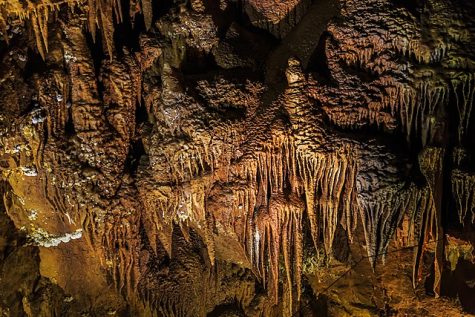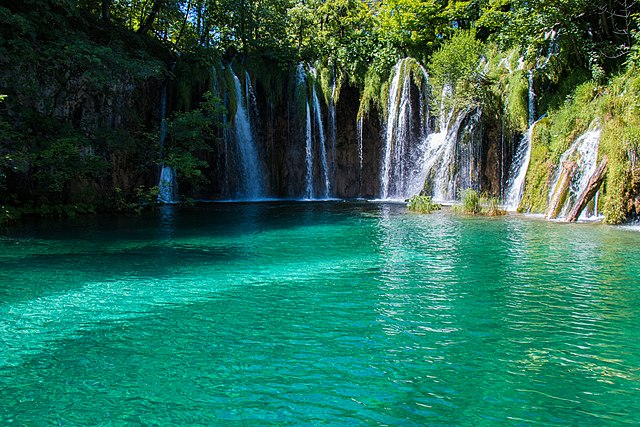Top 5 Natural Formations of Croatia
A land of wonderous natural beauty!
The many waterfalls within the Plitvice Lakes National Park draw tourists from all around the world in search of the perfect picture.
Croatia is known across the world as a country with beautiful landscapes, from picturesque islands to jagged mountains to lowland plains to pristine forests and lakes. In fact, travelers all over the world flock to Croatia as tourists, excited to experience this exquisite scenery as well as the country’s unique culture and history. Here are five of the most breathtaking places to see in this incredible country.

5: Baredine Cave. Baredine cave is a karst formation that was created through water flowing through limestone over millions of years, gradually eroding tiny cracks into massive chambers. Inside the cave, visitors are greeted with eerily beautiful rock formations, such as stalactites, stalagmites, crystalline ‘curtains’, and the cave’s centerpiece- a stalagmite known as “Snowman”. Snowman, or Snowman the Torchbearer, gets its unusual name from its distinct, snowman-like shape, and it can grow up to a centimeter per year due to the heavy water flow in its location. The cave also sports two underground lakes that are home to the rare and amazing amphibian the olm, a subterranean aquatic salamander only native the underground of Southeastern and Central Europe. Olms, referred to as “human fish” in the area due to their fleshy pink color, were once thought to be the undeveloped offspring of massive dragons living beneath the earth when they washed out of the caves in heavy rains.
4: Red Lake. Red Lake, located outside the city of Imotski, is a karst lake that boasts the title of the third largest sinkhole in the world. Even above the water the sight is striking: massive, almost vertical cliffs rise nearly eight hundred feet over the lake itself, plunging abruptly down to meet its deep blue surface and continuing far downward to a total known depth of 1739 feet. However, the sinkhole has not been fully explored and could possibly extend even deeper. Another feature of Croatia’s notable karst topography, Red Lake, or Crveno Jezero in Croatian, also has multiple caves both above and beneath the water’s surface, and may be connected with other lakes in the area through these passages. A similar formation, Blue Lake, is only a short distance from Red Lake. This sinkhole, thought to have formed in the same manner as Red Lake through the collapse of the ceiling of a cavern chamber, reaches an impressive depth of nearly nine hundred feet, but does not have nearly as steep cliffs.

3: The Dinara Mountains. The Dinaric Alps run southeast down the border between Croatia and Bosnia and Herzegovina and are home to some of the most beautiful mountaintop vistas of the Balkans. Although these mountains are remote, their rugged terrain, craggy ridges, and alpine meadows are home to a variety of wildlife, such as wolves, lynxes, various birds of prey such as falcons and eagles, and several endangered species of reptiles. The centerpiece of the region, the Dinara massif, is the tallest mountain in Croatia, reaching a peak of over six thousand feet. However, the true jewel of the Dinara Mountains is a spring that serves as the source of the Cetina river and is known as the eye of the earth- and for good reason. The oval-shaped spring is shockingly colored and almost appears to be bottomless, its aquamarine shallows contrasting with the intense dark blue of its depths to form a resemblance to an eye.
2: Plitvice Lakes National Park. This picturesque park is Croatia’s largest national park, a UNESCO World Heritage Site, and one of the most well-known natural tourist destinations in Croatia. Its primary attraction is by far its namesake: the Plitvice Lakes, a series of sixteen interconnected lakes slowly cascading downwards through waterfalls and natural dams. Unique minerals in the mountain runoff which fills the lakes allow for stunning colors of green and blue and incredibly clear water. The lakes, which can be accessed by many different trails and boardwalks, are surrounded by acres of pristine forests, which serve as a home to animals such as brown bears and wolves, which are threatened and rare in most areas. Since this park is visited by so many tourists, it can get crowded during the summer, and it is best to try and visit early in the day.
1: Blue Grotto. The Blue Grotto, also known as the Blue Cave, is located on the coast of the island of Biševo, and receives thousands of visits every year for its breathtaking view. Accessible only by boat and diving, the grotto is a sea cave that was formed over millions of years through waves eroding the island’s limestone, and is now known for its unearthly blue glow. When inside the cave, tiny cracks in the cave ceiling allow sunlight to spill down and cast the room in an eerie blue light, glimmering on the water and objects beneath it. As Biševo is a tiny, incredibly remote island, the primary way to visit the Blue Grotto is through organized tours, most of which make the trip a full-day experience by including stops at other nearby islands. Although many other sea caves exist across the world, the breathtaking colors of the Blue Cave coupled with the experience of a full tour make this formation a truly unforgettable visit.


Kirsten Smith • May 17, 2022 at 10:49 AM
I’ve actually been to the waterfall park, it is as beautiful as it is in pictures, but be prepared for a long day. We hiked over five miles and my 82 year old grandfather did it too.